According to CCTV, May 6, 2015, General Secretary Xi Jinping chaired the 12th meeting of the Central Leading Group on Comprehensive and Deepening Reform, which emphasized the need to promote innovation as the core and break down institutional barriers, and considered and approved the "overall plan for promoting comprehensive and innovative reform in some regional systems" and "Shenzhen" The implementation plan of "science and technology system reform" and other documents. The current government attaches great importance to entrepreneurship and innovation, not only including it in the government work report, but also to China's economic restructuring and growth of one of the "twin engines" of the height. Starting today, CCTV's "Economic Half Hour" program will launch a series of seven episodes of "Innovation Drives Progress" to praise the innovation! According to statistics, although 70% of the earth's surface is covered by water, only 2.5% of the fresh water is available for human use. In our country, the water environment is equally grim. In 668 counties and cities, there are more than 400 water shortages and more than 100 serious problems. The problems of water resources, water environment, water ecology and water disasters superimpose on the future development of China. And potential security risks. Then how can we solve the problem of water shortage?
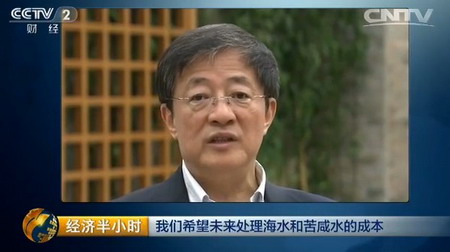
We are concerned about seawater desalination technology. According to statistics, although 70% of the earth's surface is covered by water, only 2.5% of the fresh water is available for human use, 1.1 billion people do not have access to safe drinking water, and 2.4 billion people lack adequate water and sanitation facilities. The United Nations has warned that by 2025, half of the world's population will be living in water-scarce areas, and water-scarce areas are still expanding, especially in North Africa and West Asia. In our country, the water environment is also grim, in 668 counties and cities, there are more than 400 water shortage, more than 100 serious, Dalian, Tianjin, Qingdao, Lianyungang and other cities per capita water resources are less than 200 cubic meters, in a state of extreme water shortage. The superposition of water resources, water environment, water ecology and water disasters has become a potential crisis affecting China's future development and security. Then how can we solve the problem of water shortage? For today's program, let's take a look at six Heng Dao, Zhoushan, Zhejiang.
In the past, "water shortage island" needed a day queue for water use.
Today, seawater desalination technology is two.
Liu Shengguo, the villager of Tumen Ao village, six Heng Town, Zhoushan City, Zhejiang Province: we are the most water scarce island.
CCTV finance and economics "half an hour" reporter: how many people are there in this village?
Liu Shengguo: our village has a total of more than 1100.
His name is Liu Shengguo. He is a villager in Gunlong'ao village on Liuheng Island. When he learned that reporters had come to interview them about their drinking water, he rushed to an old well in the village with reporters. He told reporters that there were more than 300 households in Gunlong'ao Village. All the water used to be supplied by the three wells in the village. Every day, they had to go to the well to pick up the water. When water was tight, each household had to line up at the well for a whole day.
Liu Shengguo: In the evening we carry a bucket. The bucket is placed in this line. We take it up and pick it up at home as soon as we scoop it up. That's what happens.
Reporter: just to fetching water every night?
Liu Shengguo: in the daytime, there are fewer people in the evening.
The well water used in the village came from the rainwater from the mountains, but in 2007, Liuheng Island had not rained for six months in succession, and eating water became the biggest problem.
Liu Shengguo: No way. All the wells are out of water. Just go to the troop tunnel and get some. It's very economical and economical. There's no way. We use kerosene lamps to carry water when we have no electric lights at night, so we carry it down on a load-by-load basis, when water is the hardest.
Remembering the scene of water shortage at that time, Liu Shengguo, who lived here for half a lifetime, is still fresh in his memory. Zhoushan is one of the cities with serious water shortage in China, and Liuheng Island is the most serious water shortage area of resource-based, and it is also the area with engineering water shortage and water quality water shortage. In the past, the water used by the residents and industrial water on the island depended on the rainwater from the sky. When the weather was dry, local government departments had to organize ships to transport water to Ningbo to solve the water problem in the island.
Zhang Youde, Mayor of Liuheng Town, Zhoushan City, Zhejiang Province: Let's go to Ningbo to ship the water. It's 20 yuan a ton. That's a terrible cost.
In 2007, there was no rain in Liuheng Island for six months. Zhang Youde was worried about the high cost of using 20 yuan per ton of water. But what worries him more is that the island's good resources, like beautiful decorations, do not work.
Zhang Youde: Our whole island is 121 square kilometers, because we are a rainwater island, the coastline is now 85 kilometers, can do 36 kilometers dock, so we invite investment to look forward to our island.
Liuheng Island is the second largest island in Zhoushan Archipelago, Zhejiang Province. Many large enterprises at home and abroad have taken a fancy to Liuheng Island's natural harbor and geographical advantages, and have long wanted to invest in this treasure spot. However, because of less reservoir on the island, fresh water resources are limited. Every winter or rainy season, the island has to stop water, which makes every enterprise to Liuheng Island investments, are hesitant. The shortage of water resources has become a bottleneck restricting the economic development of the six islands.
Zhang Youde: First of all, how do you make your water? They dare not come in without desalination. Economic development water is the first. We must have water on this island. Without water, we can do nothing.
Solving the problem of water shortage has become a difficult problem to be solved before the local government. If we can draw water from the sea water near by, then, there is almost inexhaustible sea water resources to rely on, will undoubtedly remove Zhoushan people's heart disease. Is this feasible?
Yang Bo, chief engineer of Blue Star Hangzhou Water Treatment Technology Research and Development Center Co., Ltd: Now 10,000 tons are put in this place, and two sets are put in that place.
Water Service Company, six Heng Zhen, Zhoushan, Zhejiang Province: I mean, in the future, this should be used as a backup.
Her name is Yang Bo, chief engineer of Blue Star Hangzhou Water Treatment Technology Research and Development Center Co., Ltd. When the reporter met her, she was discussing with the staff of Liuheng Town Water Company of Zhoushan City, Zhejiang Province, the placement of the 20,000-ton desalination unit.
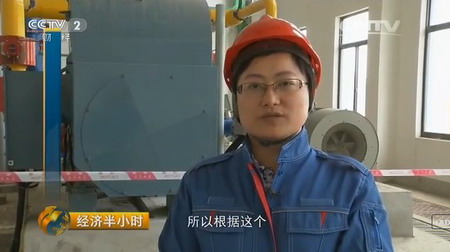
In 2008, the government of Liuheng Town reported from different levels and eventually approved by the National Development and Reform Commission to build a 100,000 tons/day desalination project on Liuheng Island, asking for fresh water from the sea to thoroughly solve the problem of lack of fresh water.
Zhang Youde: It is estimated that the cost of desalination is at most 5 to 6 yuan (per ton), so we are determined to start desalination in 2008.
In May 2008, the construction of a 100,000-ton desalination demonstration project in Liuheng Island, Zhoushan City, started. The first stage of 20,000-ton desalination plant was put into operation at the end of 2009. The second stage of the project with a daily capacity of 32,500 tons has also been completed. At present, the daily capacity of the Liuheng desalination demonstration project has reached 32,500 tons, making it the largest sea in China. Water desalination project. So how does desalination turn the muddy water into clean drinking water?
Yang Bo: This is the head of 100,000 tons of water. When I chose this water, I thought the water here was relatively less polluting, and then the fluidity of the water was better.
CCTV financial "economic half-hour" reporter: the equivalent of the water intake is here?
Yang Bo: Yes.
Reporter: the water looks a bit muddy.
Yang Bo: Yes, the water in Zhoushan is very turbid.
Here is the seawater desalination project intake, there will be 90,000 tons of seawater every day, through the intake pump pressurization, through the submarine buried pipeline, pumped to the coagulation sedimentation tank and V-shaped filter, adding chemicals for pretreatment; and then the seawater will be transferred to the reverse osmosis seawater desalination system, which is also the core of the seawater desalination process. Reverse osmosis membrane is the core of the whole desalination system. It is a membrane separation technology with the function of selective permeability (semi-permeability) membrane and pressure difference as the driving force to make water molecules continuously penetrate the membrane and intercept the impurities such as soluble salts, ions, organic matter, bacteria, viruses and so on. In order to achieve the purpose of desalination and purification; finally, the seawater will be mineralized, and ultimately make the water quality to meet the requirements of drinking water.
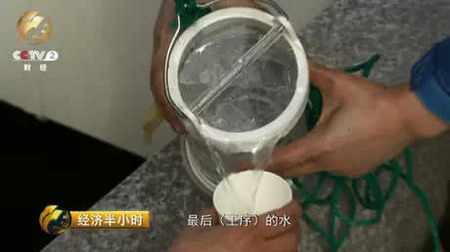
Yang Bo: This is a water produced by reverse osmosis. This is our mineralization pool. Let's take a look at it.
Reporter: clear the water.
Yang Bo: Yes.
Reporter: This is basically the last working procedure, isn't it?
Yang Bo: Yes. This is the last water.
Reporter: can I drink this?
Yang Bo: you can drink. Like we are here, drink the water directly. Please have a drink.
Reporter: no taste.
Yang Bo: is it okay? I think the taste is still a little sweet.
The island, which had been "crying thirst" in case of drought, finally said goodbye to the history of eating on the basis of the sea water desalination project. Liu Shengguo and all the residents on the island no longer need to worry about the draught.
Reporter: did you drink directly?
Liu Shengguo: it doesn't matter.
Reporter: is there any other flavor?
Liu Shengguo: same, it doesn't taste much. I was thinking, people's livelihood project is people's livelihood project, seawater desalination project is the best, it is directly beneficial to the people.
Interviewer: what do you think is good?
Liu Shengguo: That's what I think. If drought happens in other places in the future, it will never happen in our place.
Reporter: why?
Liu Shengguo: the sea is definitely not dry. There is sea water, and we have fresh water.
Reporters in the village to see, before each household of the villagers used to store water tanks, are now upside down on the ground, idle side.
Liu Shengguo: This one is all water in the house. It's all picked up and put here. It's useless now. It's just put here.
Reporter: (now) just buckle it down?
Liu Shengguo: it's buttoned up.
Reporter: now there is no need for this thing.
Liu Shengguo: no use.
Desalination has not only changed the lives of the inhabitants of Liuheng Island, but also changed the economic development of the whole town.
Zhang Youde: We are now in Zhoushan Zhongyuan dock. The output value of this enterprise is about 5 billion yuan a year. Its water supply is also supplied by our island. It supplies a lot of water. I estimate that the enterprise will have about 1 million 200 thousand tons a year, so the consumption is very large. Our enterprise is also the 50% water that we desalinated by seawater.
Mayor Zhang Youde told reporters that after the completion of the Liuheng Island desalination demonstration project, not only to protect the residents of the island's domestic water, more importantly, the island's industrial water has been adequately guaranteed, which also provides a great convenience for attracting investment in Liuheng Island.
Zhang Youde: There are many large and small enterprises, there are more than 500 enterprises, mainly rely on large enterprises to come in, large enterprises are coal and electricity, Wuhan Iron and Steel, large enterprises have come in, 2008, our enterprise industrial output value of 10 billion, now we (output value) 198 billion, the end of 2014.
Reporter: that's twice as fast.
Zhang Youde: 15% to 20% is normal.
Such an economic growth rate is unthinkable for the past six islands. Liuheng Town has invested 200 million yuan to build a demonstration project for desalination, but Zhang Youde told reporters that the project has reduced their water cost from 20 yuan per ton to 5 yuan per ton in the past, not only solving the problem of water consumption for the residents of the island, but also attracting a large number of enterprises to settle in, which is a good deal. Come on.
Zhang Youde: You don't even have water on Liuheng Island, and people won't come in. Where can I get a billion dollars in taxes from Liuheng Island?
After the rain, Shanxi was once a precious freshwater resource for the residents of Liuheng Island. Now we can see the strategic value of desalination when we see that the desalinated drinking water can be continuously supplied to the residents of the whole island, no longer need to rely on the weather to eat water. In fact, as early as the 1960s, China has begun to study the technology of seawater desalination. After more than 50 years of development, China's seawater desalination technology is not only in the membrane separation technology, but also in the key equipment and engineering technology has been in the forefront of the world, becoming the world's few countries to master seawater desalination. One of the family. These technological innovations have also greatly promoted our domestic desalination technology to go abroad.
From nothing to strength
Seawater desalination technology goes abroad
Gao Congshe, academician of the Chinese Academy of Engineering, poured the solution onto the glass plate, then scraped a film, evaporated for a certain time, 20 seconds, 30 seconds, humidity and temperature to control, and then put it in the water, the solvent inside the water ran into the water, then the original polymer formed a film.
The film formed on glass is the most important reverse osmosis membrane technology for seawater desalination. Scientists have discovered that when pure solvents and solutions are separated by semipermeable membranes, pure solvents flow spontaneously through the membranes into the solution phase, which is called reverse osmosis. By reversing the osmosis sequence, water can be collected through pressure and salt can be filtered out. This technique is called reverse osmosis.
Compared with the traditional electrodialysis and distillation, this reverse osmosis membrane technology has the greatest characteristics of energy saving, producing the same quality of fresh water, its energy consumption is only 1/4 of the distillation method. The world's first to study reverse osmosis membrane technology is the United States.
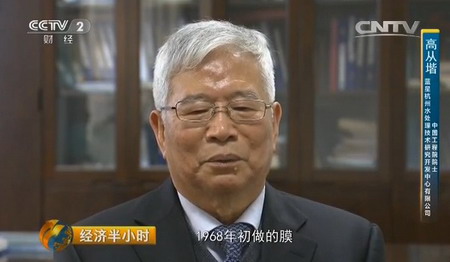
Gao Congshe: The membrane technology abroad started in the United States. In 1953, a professor suggested that the membrane desalination be included in the national plan.
Because of the high energy consumption of traditional electrodialysis and distillation technology, there is a fierce competition in the international research and development of membrane technology. As one of the earliest domestic scientists who began to study seawater desalination reverse osmosis membrane technology, Gao Congshe participated in the desalination battle which was composed of many scientific research institutions in China in 1967.
Gao Congshe: It was reported that cellulose acetate membrane could be used for seawater desalination at that time. But what kind of cellulose acetate membrane it used, what kind of solvent it used, what kind of additives it used and under what conditions it could be made are all confidential.
Every link, from material to formula to production conditions, has to undergo thousands of experiments and failures. After continuous improvement and analysis, great breakthroughs have been made.
Gao Congshe: The happiest one is the membrane made in early 1968. The desalination rate has reached 95% and 96% above, and the water flux has reached our expected target. Everyone is very happy and thinks it is hopeful. That is to solve our country has never met the membrane of seawater desalination, has been able to meet the goal of seawater desalination membrane.
The National Seawater Desalination Conference in 1967-1969 laid a foundation for the development of asymmetric reverse osmosis membranes for cellulose acetate. In the 1970s, the state mainly studied and developed hollow fiber and rolled reverse osmosis membranes. In the 1980s and 1990s, the reverse osmosis composite membranes were mainly studied and developed, and began to develop in the water treatment industry in China. It has been applied.
Zheng Genjiang, General Manager and Secretary of the Party Committee of Lanxing Hangzhou Water Treatment Technology Research and Development Center Co., Ltd.: The first application of membrane reverse osmosis seawater desalination in our country should be in Shengshan Island, Shengsi, Zhejiang Province, at that time the output was 500 tons per hour, per day.
However, in 2000, the state deepened the reform of the scientific and technological system, and some scientific research institutes were no longer allocated research funds, which made the Hangzhou water treatment technology research and development center, which was in the leading position in seawater desalination technology, once in a predicament, and the development and application of seawater desalination technology also encountered serious obstacles.
Zheng Genjiang: Faced with two major bottlenecks, the first is the problem of funds, because the center's goal is not only to research, but also to develop industries, the industry needs a large amount of capital input, at that time the capital is very scarce, this is one point; the second point, the center was originally the research and development department, to transfer to the industry track. To be in line with the market and turn to industrialization is a big problem. We will only do research, but we will not sell anything.
In 2006, after nearly six years of contacts and negotiations, Hangzhou Water Treatment Technology Research and Development Center joined the Blue Star Group, which had been working on the desalination of brackish water at that time.
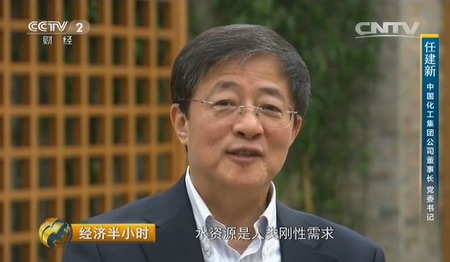
Ren Jianxin, chairman of China Chemical Corporation and chairman of Blue Star Group: Water resources are the rigid needs of human beings, especially China's water resources. On an average per capita basis, we are a water-deficient country in the world. This resource is very valuable to us. There is no doubt that everyone sees a very good market outlook. Where do you think water comes from and where does desalination come from? It is in the desalination of seawater, one of the applications of desalination do very well, that is, a lot of desalination equipment is produced by Hangzhou water.
Hangzhou Water Treatment Technology Research and Development Center has received 150 million yuan of financial support after joining Bluestar Group, which not only ensures the research and development of seawater desalination membrane technology, but also promotes the independent innovation of seawater desalination technology in key equipment and engineering technology. Liuhengdao 100,000 tons desalination project is the first project to be launched after the restructuring of Hangzhou Water Treatment Technology Research and Development Center.
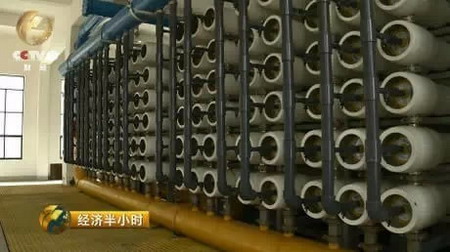
Yang Bo: This is the largest mainframe in our country at present, a daily output of 12 thousand and 500 tons.
This is the first successful development of a 10,000-ton RO desalination unit in China. It is also the most large-scale RO desalination project in the world. Yang Bo told reporters that the next desalination project in Liuheng Island, according to the island's population and industrial water demand, the need for 100,000 tons, which means the need to equip with 10,000 tons of reverse osmosis desalination unit, but to build a 10,000 tons of desalination unit, how to evenly distribute water, Become one of the biggest technical difficulties.
From 1.5 inch to 4 inch, after numerous simulations and field tests, Yang Bo finally adopted the domestic first large caliber pressure vessel interface form, forming a 10,000-ton desalination unit.
Yang Bo: The whole test run is very stable, the performance parameters and the final water quality have reached the standard of biological drinking water. Especially if we are very happy, the whole power consumption is very low. It should be said that this power consumption has reached the lowest level in China and is used internationally. The index of electricity is also a very good low value, that is, the power consumption of one ton of water is only 2.6 degrees.
This 10000 cubic meters per day reverse osmosis desalination unit design and manufacturing technology results, filling the domestic gap. In the construction of Liuhengdao seawater desalination project, energy recovery, high-pressure pumps and many other key equipment in large-scale reverse osmosis seawater desalination projects have gradually broken the dependence on foreign products.
Yang Bo: This is a very core part, because reverse osmosis energy consumption is relatively high, by energy recovery, you can recover nearly 60% of the total energy, so that is a key part of the drop in energy consumption per ton of water.
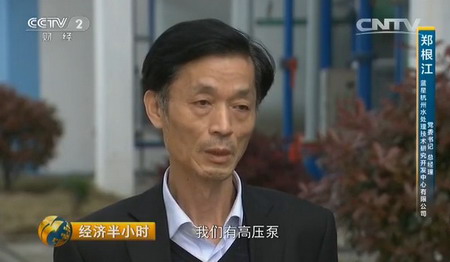
Zheng Genjiang: We have high-pressure pumps, energy recovery, membranes, pressure vessels, which are the four key equipment in seawater desalination. They are all successfully developed through the implementation of this project and used in our seawater desalination project. Therefore, the localization rate of this project is very high, which has reached about 70%.
The increase of localization rate has broken the monopoly of overseas key equipment in seawater desalination and fundamentally broken the foreign technical barriers.
Zheng Genjiang: Not only can it replace foreign products, but also the prices of foreign products have dropped dramatically since our development. This is actually a big barrier.
CCTV finance and economics "half an hour" reporter: how much?
Zheng Genjiang: like the film, it probably dropped by 40% to 50%.
Zheng Genjiang: This base should be a national seawater desalination industrial base batched by the National Development and Reform Commission. The industrial base is basically divided into two parts, one is the equipment manufacturing base, and the other is the research and development center. These two parts are composed.
This 150 mu desalination production base with a total investment of 650 million yuan was built in 2012. It mainly produces all kinds of high-performance membrane and membrane packers, as well as all kinds of complete equipment and key equipment for desalination. After the completion of the project, it will have the capacity to produce 5 million square meters of membrane annually and 700,000 tons of equipment per day.
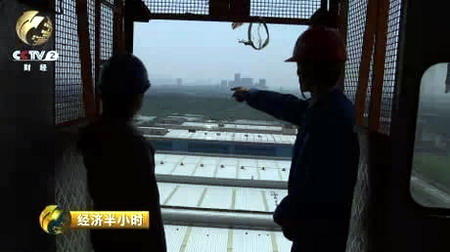
Zheng Genjiang: what is the concept of this 700 thousand ton? It's a drinking water equivalent to solving 3.5 million of our population, so it's big in the world.
This seawater desalination production base covers an area of 150 mu with a total investment of 650 million yuan. It mainly produces all kinds of high-performance membrane and membrane packers, various complete sets of equipment and key equipment for seawater desalination.
After more than 50 years of scientific and technological research and development, China's desalination field, not only experienced the emergence, but also formed from the independent research and development of reverse osmosis membrane technology, to the independent production of key equipment, and then to the independent general contracting of engineering and technological integration of service solutions.
According to the Global Trend and Forecast Report on the Seawater Desalination Equipment Market 2013-2018 issued by Markets and Markets, the market value of the global seawater desalination equipment market will reach 15.274 billion US dollars. The Middle East will become the largest market for seawater desalination equipment in the future, and the surrounding countries due to oil and natural resources. Gas, chemical industry, power industry and industrial market have strong demand for seawater desalination. Such a huge global desalination market and the development strategy of "one belt and one road" have created an opportunity to "go out" for China's seawater desalination technology.
Desalination technology "go out" equipment exports more than 10 countries
Meng Youguo, deputy general manager of Bluestar Hangzhou Water Treatment Technology Research and Development Center Co., Ltd: This tie will not wear for a long time.
At 10 a.m., Meng Youguo, deputy general manager of Bluestar Hangzhou Water Treatment Technology Research and Development Center Co., Ltd., is making elaborate preparations for the coming Austrian businessmen.
CCTV finance and economics "half an hour" reporter: what are they talking about this time?
Meng Youguo: a desalination project in the United Arab Emirates.
Reporter: what is the scale of this project?
Meng Youguo: It is a 130,000-ton daily desalination project. It is a supporting project for the 2020 Dubai World Expo.
Meng Youguo: (is it)?
It can be seen that Meng You Guo, who is standing at the door to greet foreign businessmen, seems a little cautious and nervous.
Meng Youguo: a little nervous and excited.
Reporter: why?
Meng Youguo: Because this is the first substantive negotiation on such a big project that we really went abroad.
Today, the two Austrian businessmen came to the production base of Blue Star Hangzhou Water Treatment Research and Development Center to inspect the capacity of membrane components and production equipment. They hope to join Blue Star Hangzhou Water Treatment Technology Research and Development Center Co., Ltd. in bidding for a 130,000-ton desalination project in Dubai. Blue Star Hangzhou Water Treatment Technology Research and Development Center Co., Ltd. won the favor of foreign businessmen, mainly from the Caofeidian desalination project contracted by Blue Star Group in 2011, which is the largest international tender desalination project contracted by domestic enterprises, in some powerful countries Among the competitors, LAN-STAR Hangzhou water treatment technology research and Development Center Limited won the top spot. Let the world know and recognize China's desalination technology in the sea equipment manufacturing capacity and engineering service capacity, many foreign users find him to negotiate cooperation.
Zheng Genjiang: is this from Iran?
Staff: Yes, this is from Iran.
Zheng Genjiang: when are you going to deliver the goods?
Staff: this preparation will be shipped at the end of this month.
Zheng Genjiang: This is a relatively large technology project. We must do well in quality and quantity. Where is Indonesia's project?
Zheng Genjiang is carefully inspecting the desalination membrane assembly units to be sent to Indonesia, Iran, the Philippines and other countries in May. At present, their products have been exported to 12 countries and regions.
Zheng Genjiang: We have already exported nearly 30 sets of complete sets of equipment to nearly 15 countries. This year, it is estimated that there will be nearly 40 sets. We are negotiating. We also hope that through our domestic and foreign market expansion and application, we can develop into the world's famous desalination equipment manufacturers and suppliers.
The demand for seawater desalination in the world is increasing rapidly, and the development strategy of "one belt and one road" will bring new opportunities for China's desalination technology to "go out".
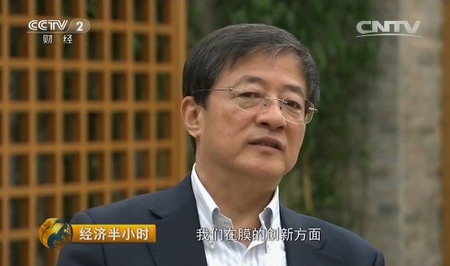
Ren Jianxin: When you go to the sea along the Silk Road, seawater desalination will play a very important role. If you go to the direction of the ancient Silk Road, our brackish water will play a very important role. It is desalinating our seawater and brackish water, that is, our desalination and brackish water desalination will take place in Southeast Asia. The role of brackish water desalination in East Asia will play a great role. In the future, our ability to optimize and upgrade membrane technology and membrane materials is very, very strong. I believe we have a bigger breakthrough in membrane innovation, which means we can lower the cost. We hope that the cost of treating seawater and brackish water in the future can be reduced to exactly the same as that of tap water treatment.
Half an hour observation:
China is a country with serious water shortage. The only way to alleviate water shortage is to increase revenue and reduce expenditure. In order to achieve this goal, seawater desalination is a fast and effective method, which is a very powerful supplement to alleviate the serious shortage of water resources in China. Under the guidance of the government and the efforts of scientific researchers, China's "seawater desalination" technology has finally squeezed into people's vision and stepped onto the international stage after a long 50 years. Some agencies predict that by 2018, the market value of the global desalination equipment market will be expected to reach US $15 billion 274 million. The industrialization of seawater desalination is speeding up and the market prospect is expected. Facing the industry with broad market prospects, the planning and guidance of a series of seawater desalination industries in the next stage should also become the top priority.